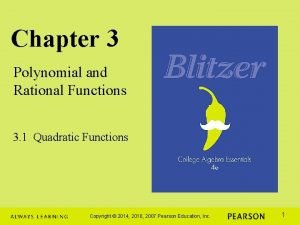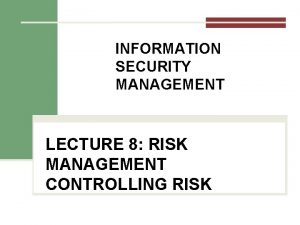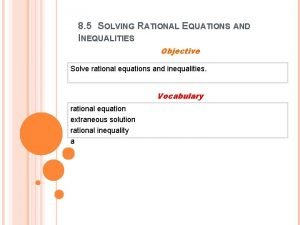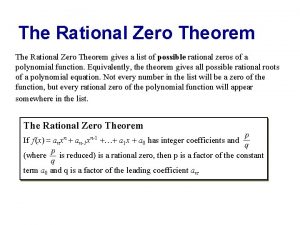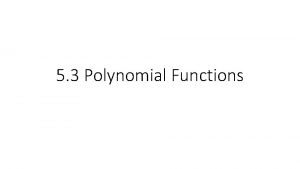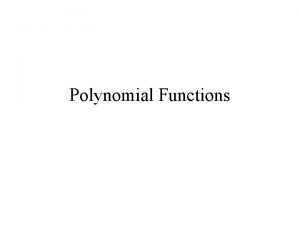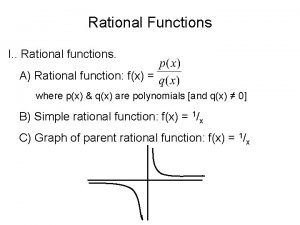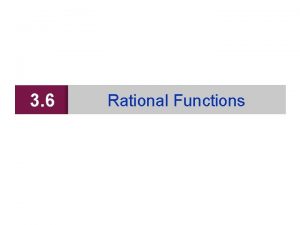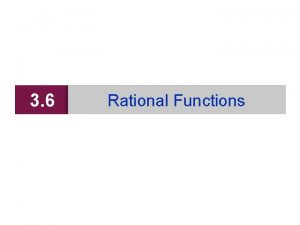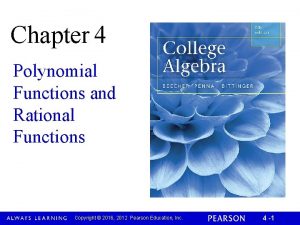2 Polynomial and Rational Functions Copyright Cengage Learning












































- Slides: 44

2 Polynomial and Rational Functions Copyright © Cengage Learning. All rights reserved.

2. 3 Real Zeros of Polynomial Functions Copyright © Cengage Learning. All rights reserved.

What You Should Learn • Use long division to divide polynomials by other polynomials. • Use synthetic division to divide polynomials by binomials of the form (x – k). • Use the Remainder and Factor Theorems. 3

What You Should Learn • Use the Rational Zero Test to determine possible rational zeros of polynomial functions. • Use Descartes’s Rule of Signs and the Upper and Lower Bound Rules to find zeros of polynomials. 4

Long Division of Polynomials 5

Long Division of Polynomials Read this slide, but you do not need to write it down: Consider the graph of f (x) = 6 x 3 – 19 x 2 + 16 x – 4. Notice in Figure 2. 25 that x = 2 appears to be a zero of f. Because f (2) = 0, you know that x = 2 is a zero of the polynomial function f, and that (x – 2) is a factor of f (x). This means that there exists a second-degree polynomial q (x) such that f (x) = (x – 2) q (x). To find q (x), you can use long division of polynomials. Figure 2. 25 6

Example 1 – Long Division of Polynomials Divide 6 x 3 – 19 x 2 + 16 x – 4 by x – 2, and use the result to factor the polynomial completely. Solution: 7

Example 1 – Solution cont’d You can see that 6 x 3 – 19 x 2 + 16 x – 4 = (x – 2)(6 x 2 – 7 x + 2) = (x – 2)(2 x – 1)(3 x – 2). Read the part below, but don’t write it: Note that this factorization agrees with the graph of f (see Figure 2. 25) in that the three x-intercepts occur at x = 2, x = , and x =. Figure 2. 25 8

Long Division of Polynomials 9

Long Division of Polynomials The Division Algorithm can also be written as Read the part below, but you do not need to write it down: In the Division Algorithm, the rational expression f (x)/d (x) is improper because the degree of f (x) is greater than or equal to the degree of d (x). On the other hand, the rational expression r (x)/d (x) is proper because the degree of r (x) is less than the degree of d (x). 10

Long Division of Polynomials Before you apply the Division Algorithm, follow these steps. 1. Write the dividend and divisor in descending powers of the variable. 2. Insert placeholders with zero coefficients for missing powers of the variable. 11

Synthetic Division 12

Synthetic Division There is a nice shortcut for long division of polynomials when dividing by divisors of the form x – k. The shortcut is called synthetic division. The pattern for synthetic division of a cubic polynomial is summarized as follows. (The pattern for higher-degree polynomials is similar. ) 13

Synthetic Division This algorithm for synthetic division works only for divisors of the form x – k. Remember that x + k = x – (–k). 14

Example 4 – Using Synthetic Division Use synthetic division to divide x 4 – 10 x 2 – 2 x + 4 by x + 3. Solution: You should set up the array as follows. Note that a zero is included for each missing term in the dividend. 15

Example 4 – Solution cont’d Then, use the synthetic division pattern by adding terms in columns and multiplying the results by – 3. So, you have 16

The Remainder and Factor Theorems 17

The Remainder and Factor Theorems The remainder obtained in the synthetic division process has an important interpretation, as described in the Remainder Theorem. The Remainder Theorem tells you that synthetic division can be used to evaluate a polynomial function. That is, to evaluate a polynomial function f (x) when x = k, Divide f (x) by x – k the remainder will be f (k). 18

Example 5 – Using the Remainder Theorem Use the Remainder Theorem to evaluate the following function at x = – 2. f (x) = 3 x 3 + 8 x 2 + 5 x – 7 Solution: Using synthetic division, you obtain the following. Because the remainder is r = – 9, you can conclude that f (– 2) = – 9. r = f (k) 19

Example 5 – Solution cont’d This means that (– 2, – 9) is a point on the graph of f. You can check this by substituting x = – 2 in the original function, but this is only to check your answer. Check f (– 2) = 3(– 2)3 + 8(– 2)2 + 5(– 2) – 7 = 3(– 8) + 8(4) – 10 – 7 = – 24 + 32 – 10 – 7 = – 9 20

The Remainder and Factor Theorems Another important theorem is the Factor Theorem. This theorem states that you can test whether a polynomial has (x – k) as a factor by evaluating the polynomial at x = k. If the result is 0, then (x – k) is a factor. 21

Example 6 – Factoring a Polynomial: Repeated Division Show that (x – 2) and (x + 3) are factors of f (x) = 2 x 4 + 7 x 3 – 4 x 2 – 27 x – 18. Then find the remaining factors of f (x). Solution: Using synthetic division with the factor (x – 2), you obtain the following. 22

Example 6 – Solution cont’d Take the result of this division and perform synthetic division again using the factor (x + 3) and the bottom line of the previous division becomes the top of this division. Because the resulting quadratic factors as 2 x 2 + 5 x + 3 = (2 x + 3)(x + 1) the complete factorization of f (x) is f (x) = (x – 2)(x + 3)(2 x + 3)(x + 1). 23

The Remainder and Factor Theorems 24

The Rational Zero Test 25

The Rational Zero Test relates the possible rational zeros of a polynomial (having integer coefficients) to the leading coefficient and to the constant term of the polynomial. 26

The Rational Zero Test To use the Rational Zero Test, first list all rational numbers whose numerators are factors of the constant term and whose denominators are factors of the leading coefficient. 27

Example 7 – Rational Zero Test with Leading Coefficient of 1 Find the rational zeros of f (x) = x 3 + x + 1. Solution: Because the leading coefficient is 1, the possible rational zeros are simply the factors of the constant term. Possible rational zeros: ± 1 By testing these possible zeros, you can see that neither works. f (1) = (1)3 + 1 =3 f (– 1) = (– 1)3 + (– 1) + 1 = – 1 28

Example 7 – Solution cont’d So, you can conclude that the polynomial has no rational zeros. Note from the graph of f in Figure 2. 27 that f does have one real zero between – 1 and 0. However, by the Rational Zero Test, you know that this real zero is not a rational number. Figure 2. 27 29

The Rational Zero Test When the leading coefficient of a polynomial is not 1, the list of possible rational zeros can increase dramatically. The Factor Theorem and synthetic division should be used to test the possible rational zeros. 30

Example 8 – Using the Rational Zero Test Find the rational zeros of f (x) = 2 x 3 + 3 x 2 – 8 x + 3. Solution: The leading coefficient is 2 and the constant term is 3. Possible rational zeros: By synthetic division, you can determine that x = 1 is a rational zero. 31

Example 8 – Solution cont’d So, f (x) factors as f (x) = (x – 1)(2 x 2 + 5 x – 3) = (x – 1)(2 x – 1)(x + 3) and you can conclude that the rational zeros of f are x = 1, x = and x = – 3, as shown in Figure 2. 28 32

Other Tests for Zeros of Polynomials 33

Other Tests for Zeros of Polynomials Read this slide, but do not write it down: You know that an nth-degree polynomial function can have at most n real zeros. Of course, many nth-degree polynomials do not have that many real zeros. For instance, f (x) = x 2 + 1 has no real zeros, and f (x) = x 3 + 1 has only one real zero. The following theorem, called Descartes’s Rule of Signs, sheds more light on the number of real zeros of a polynomial. 34

Other Tests for Zeros of Polynomials 35

Other Tests for Zeros of Polynomials A variation in sign means that two consecutive (nonzero) coefficients have opposite signs. When using Descartes’s Rule of Signs, a zero of multiplicity k should be counted as zeros. For instance, the polynomial x 3 – 3 x + 2 has two variations in sign, and so has either two positive or no positive real zeros. Because x 3 – 3 x + 2 = (x – 1)(x + 2) you can see that the two positive real zeros are x = 1 of multiplicity 2. 36

Example 9 – Using Descartes’s Rule of Signs Describe the possible real zeros of f (x) = 3 x 3 – 5 x 2 + 6 x – 4. Solution: The original polynomial has three variations in sign. 37

Example 9 – Solution cont’d The polynomial f (–x) = 3(–x)3 – 5(–x)2 + 6(–x) – 4 = – 3 x 3 – 5 x 2 – 6 x – 4 has no variations in sign. So, from Descartes’s Rule of Signs, the polynomial f (x) = 3 x 3 – 5 x 2 + 6 x – 4 has either three positive real zeros or one positive real zero, and has no negative real zeros. Read the next two slides, but do not write them down. 38

Other Tests for Zeros of Polynomials Another test for zeros of a polynomial function is related to the sign pattern in the last row of the synthetic division array. This test can give you an upper or lower bound of the real zeros of f, which can help you eliminate possible real zeros. A real number c is an upper bound for the real zeros of f when no zeros are greater than c Similarly, c is a lower bound when no real zeros of f are less than c. 39

Other Tests for Zeros of Polynomials 40

Example 11 – Finding the Zeros of a Polynomial Function Find all the real zeros of f (x) = 10 x 4 – 15 x 3 – 16 x + 12 x. Solution: Remove the common monomial factor x to write f (x) = 10 x 4 – 15 x 3 – 16 x 2 + 12 x = x(10 x 3 – 15 x 2 – 16 x + 12). So, x = 0 is a zero of f. You can find the remaining zeros of f by analyzing the cubic factor. Because the leading coefficient is 10 and the constant term is 12, there is a long list of possible rational zeros. 41

Example 11 – Solution cont’d Possible rational zeros: With so many possibilities (32, in fact), it is worth your time to use a graphing utility to focus on just a few. By using the trace feature of a graphing utility, it looks like three reasonable choices are x = and x = 2 (see Figure 2. 31). Figure 2. 31 42

Example 11 – Solution cont’d Synthetic division shows that only x = 2 works. (You could also use the Factor Theorem to test these choices. ) So, x = 2 is one zero and you have f (x) = x(x – 2)(10 x 2 + 5 x – 6). 43

Example 11 – Solution cont’d Using the Quadratic Formula, you find that the two additional zeros are irrational numbers. 0. 56 and – 1. 06 44
 Cengage chapter 7
Cengage chapter 7 Chapter 4 polynomial and rational functions
Chapter 4 polynomial and rational functions Chapter 3 polynomial and rational functions
Chapter 3 polynomial and rational functions Chapter 3 polynomial and rational functions
Chapter 3 polynomial and rational functions Delmar cengage learning medical terminology
Delmar cengage learning medical terminology Chapter 5 the cardiovascular system labeling exercises
Chapter 5 the cardiovascular system labeling exercises Cengage learning heart diagram
Cengage learning heart diagram South-western cengage learning
South-western cengage learning 2009 delmar cengage learning
2009 delmar cengage learning 2009 delmar cengage learning
2009 delmar cengage learning Cengage learning heart diagram
Cengage learning heart diagram Introduction to medical terminology chapter 1 answer key
Introduction to medical terminology chapter 1 answer key Cengage learning australia
Cengage learning australia 2009 delmar cengage learning
2009 delmar cengage learning Cengage learning
Cengage learning Cengage learning
Cengage learning Wadsworth cengage learning
Wadsworth cengage learning Cengage learning
Cengage learning Cengage learning plant cell
Cengage learning plant cell Cengage learning
Cengage learning Cengage learning
Cengage learning Brooks cole cengage learning
Brooks cole cengage learning Chapter 7:10 respitory system
Chapter 7:10 respitory system 2014 cengage learning accounting answers
2014 cengage learning accounting answers Cengage learning
Cengage learning Cengage learning
Cengage learning 2009 delmar cengage learning
2009 delmar cengage learning Cengage learning
Cengage learning Chapter 10 cultural diversity
Chapter 10 cultural diversity Cengage learning
Cengage learning 2012 cengage learning
2012 cengage learning Cengage learning 2013
Cengage learning 2013 Cengage learning psychology
Cengage learning psychology Course technology cengage learning
Course technology cengage learning Course technology cengage learning
Course technology cengage learning Course technology cengage learning
Course technology cengage learning Course technology cengage learning
Course technology cengage learning 2016 cengage learning
2016 cengage learning Delmar cengage learning instructor resources
Delmar cengage learning instructor resources 2014 cengage learning
2014 cengage learning 2010 cengage learning
2010 cengage learning How to solve rational equations and inequalities
How to solve rational equations and inequalities Numpy.polynomial.polynomial
Numpy.polynomial.polynomial How to divide a polynomial by another polynomial
How to divide a polynomial by another polynomial P's and q's math
P's and q's math



